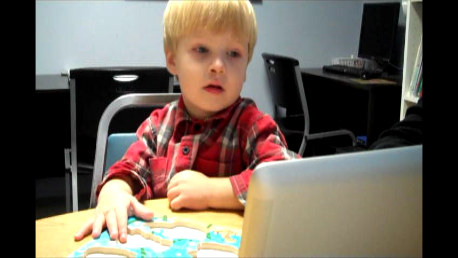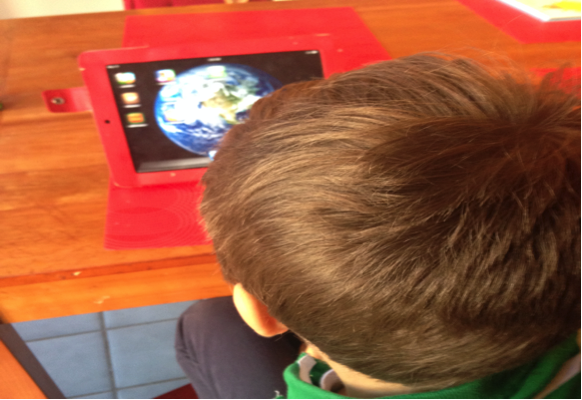Step 2 Using Video Modeling
![]()

The following steps describe the process of using or implementing the video modeling intervention.
Step 2.1 Arrange the environment for video modeling intervention
Just as the adult arranged the environment to record the video, the environment must also be suitable for the young child with ASD to watch the video and learn how to use the targeted skill.
- The location where the video will be watched should be identified and the location should be a part of the young child’s natural environment.
- The toddler should be either seated at an appropriately sized table and chair or kneeling to watch the video at eye level.
Other considerations include:
- Limiting distractions during video watching (TV, music, other children, adults talking, etc.)
- Setting up the materials that will be needed for performing the skill immediately following the video

Step 2.2 Choose a time to show the video
Incorporate the showing of the video into the child’s routine or schedule.
If using the video to improve eating, show the video just prior to snack of a meal. When using VM for learning a skill, have the parent help identify when that skill would naturally occur during the toddler day. In each case, the video should be shown prior to the child executing the targeted skill. If the video shows the child washing his/her hands after using the bathroom, the video should be shown before entering the bathroom.
Remember, the video should be shown just before the target behavior is to be used in a functional way (e.g., if targeted behavior is washing hands, the video model will be shown right before washing hands).
Step 2.3 Show the video model
 VIDEO: Showing the Video Model
VIDEO: Showing the Video Model
Many young children with ASD will sit down to watch the video without any difficulty; however, some may need additional prompting and reinforcement to attend to the entire video. The adult may have to sit and watch the video with the child. A high level of enthusiasm and excitement by the adult is a natural way to reinforce the child to sit and attend to the video.

- Some children may need a prompt to focus on key behaviors demonstrated by the video (see prompting module for additional information), which is why minimizing distractions is important.
- Showing the video will visually demonstrate or teach the target behavior to the young child with ASD. If the child is irritable or has difficulty sitting, you may need to determine the cause or show the VM at a later time.
Ideally, the child should be able to watch the entire video and then execute the desired behavior. In most cases, the video should only be shown once before assessing if the targeted behavior is learned. The practitioner or parent can then observe (collect data) to see if the child is successful in executing the targeted behavior and record what was accomplished.

If the skill is complex and is broken down into steps, each step should be viewed, then demonstrated by the child. The entire behavior or skill sequence can be executed once all of the steps are learned.
Remember, it is important to use the same procedures during the implementation phase as those that were used when the toddler was introduced to the video viewing process (i.e., incorporating the VM viewing device). The only difference is that during the initial introduction, the young child watched something other than the video model (their favorite TV program, etc.).
During implementation, the young child will watch the video model completing the task or skill that is to be learned.
Step 2.4 Implement an activity to engage the skill or behavior
After the young child watches the video, the child’s behavior is then observed during an activity or condition that stimulates or provokes the desired behavior. For example, if the targeted skill is to complete a puzzle, then the follow-up activity to watching the VM will be the child attempting to complete the same puzzle. The task or targeted skill should match the VM.
 VIDEO: Implementing the Video Model
VIDEO: Implementing the Video Model
Some questions to consider when implementing video modeling:
- How often do I show the video?
- Do I tell the child what to look for?
- Do I provide feedback to the child?
Some of these questions will be addressed in the monitoring progress (Step 3) section.
Practice Scenarios: Implementing Video Modeling
Home-based Setting Video
 Video: Video Modeling with Aiden, One Month later
Video: Video Modeling with Aiden, One Month later
Center-based Setting Video
 Video: Video Modeling with a Peer
Video: Video Modeling with a Peer
Knowledge Check

Question:
When implementing the video model intervention, when should the video be shown to the toddler?
Question:
What are the key steps in implementing video modeling?
Question:
What are two factors that adults need to consider when arranging the environment?
Question:
What should you do if the toddler does not want to watch the video?
Question:
What should you do immediately after watching the video model with the toddler?


